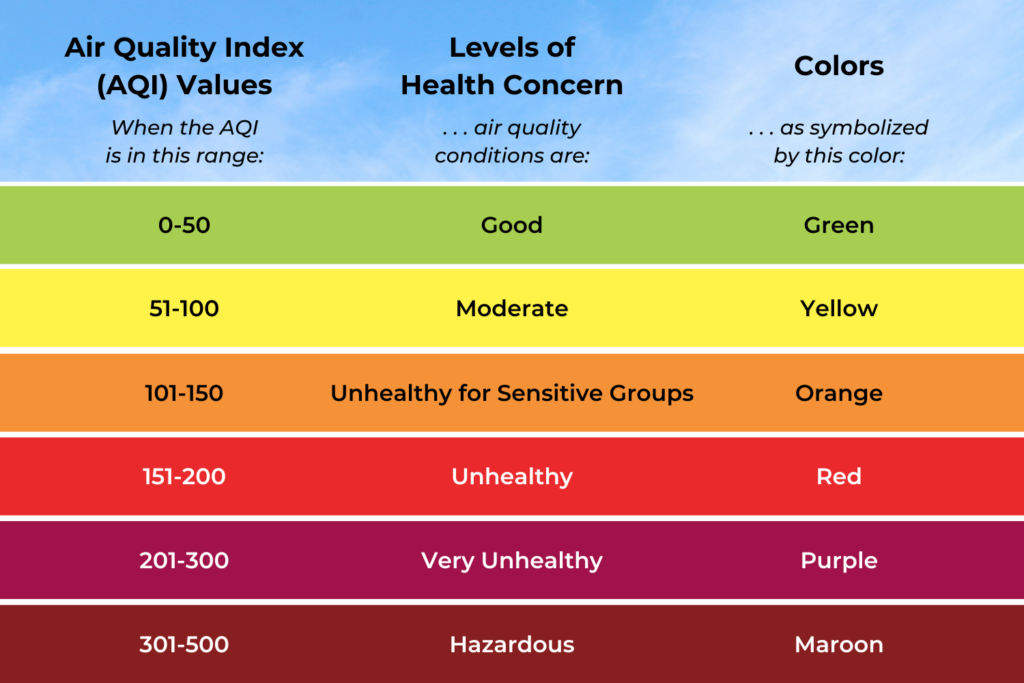The Air We Breathe (But Shouldn’t)

Summer’s here. That means more time outdoors, playing and exercising. It also means wildfire season.
Hazy, smoky air from wildfires is no stranger to our area, but how much of a health risk is poor air quality anyway? And how do we even know if our air is healthy or unhealthy?
AIR QUALITY INDEX
The air quality index (AQI) is used to convert pollutant concentrations into understandable health risk language. The U.S. Environmental Protection Agency (EPA) created a color-coded measuring system to do just this. The AQI helps you understand what local daily air quality means to your health. Its measure is on a scale of 0-500, with a higher number meaning greater air pollution and therefore, a higher health risk/concern.
The EPA uses four pollutants to calculate the AQI:
- Ground level ozone
- Particle pollution
- Carbon monoxide
- Sulfur dioxide
Concentrations of these pollutants are recorded daily at 1000+ locations around the U.S. Most smart phones include local AQI on their weather apps, but you can also find it at www.airnow.gov.
AQIs can vary seasonally with some pollutants higher in colder months (carbon monoxide) and others higher in warmer months (ozone). Things like rush hour traffic and smoke from wildfires or even wood-burning stoves also affect the AQI.
WHAT ARE THE HEALTH RISKS AND WHO IS MOST AT RISK?
Health Risks: These can vary depending on which of the four pollutant concentrations exceeds the normal range. The most common risks include:
- Irritated respiratory system (ozone, sulfur dioxide)
- Reduced lung function (ozone, particle pollution)
- Inflamed or damaged cells in lung tissue (ozone)
- Increased susceptibility to infection (ozone, particle pollution)
- Aggravated asthma (ozone, particle pollution, sulfur dioxide)
- Aggravated chronic lung disease (ozone)
- Permanent lung damage (ozone)
- Chest pain/heart palpitations for those with cardiovascular disease (particle pollution, sulfur dioxide, carbon monoxide)
Who Is At Risk: In some cases, pollutants can affect even healthy individuals if the AQI is high enough, but for the most part, the following tend to be most at risk:
- People with lung disease (asthma, chronic lung disease, emphysema, bronchitis)
- Children, who typically play outside more than other age groups
- Older adults, who are more likely to have pre-existing lung disease
- Active people, who exercise outdoors
- Young infants or fetuses (carbon monoxide)
STEPS TO TAKE
While these measures will not necessarily make you immune to poor air quality, they can help lower your risk of health problems. Depending on the AQI for specific pollutants, you can take various measures to protect your health. For example, if you have heart disease, avoiding sources of carbon monoxide, such as heavy traffic, is an important step you can take.
Generally, when there are elevated levels of air pollutant, you want to avoid:
- Prolonged exertion, which is any outdoor activity that causes slight increased breathing for long periods of time, and
- Heavy exertion, which is intense outdoor activity that causes heavy breathing.
Avoiding these by reducing the time spent outside or the intensity of the activity are two important measures.
Pulmonologist Seth Hartung, MD, urges individuals to monitor local AQI and to take the above precautions if the number goes above 101 and moves to the “unhealthy for sensitive groups” level.
“We typically see an increase in our Emergency Department and office visits for respiratory symptoms in the summer months due to air quality issues,” he said.
If you are experiencing increased respiratory symptoms or have concerns about your lung health, contact the Island Pulmonology clinic at 360.299.4273.
